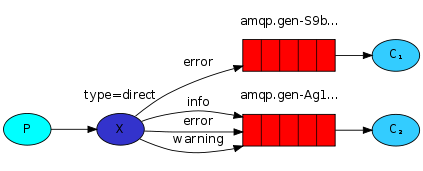RabbitMQ Routing
Routing (using the Java Client)
- Publish/Subscribe에서는 모든 메세지를 수신했다
- Routing 기능을 이용하여 특정 메세지만 수신가능하도록 변경할 것이다
Bindings
channel.queueBind(queueName, EXCHANGE_NAME, "");
- Binding은 Exchange와 Queue와의 관계를 설정하는 것이다
- Queue는 이 Exchange가 주는 메세지만 수신한다는 것으로 볼 수 있다
-
queueBind 메소드는 routingKey 파라미터를 가질수 있다
channel.queueBind(queueName, EXCHANGE_NAME, "black"); // routingKey : "black" - routingKey는 exchange Type에 영향을 받는다
- fanout으로 설정할 경우 routingKey 설정은 무시된다
Direct exchange
- direct exchange의 원리는 단순하다
- routingKey와 매칭되는 메세지만 전달한다

- exchange X에 두개의 Queue(Q1, Q2)가 Binding 되어 있다
- 첫 번째 Queue의 routingKey는 orage이다
- 두 번째 Queue의 routingKeys느 black, green이다
- routingKey를 orage로 설정하고 메세지를 publish 하면 Q1에 들어가진다
- routingKey를 black 혹은 green으로 설정한 메세지는 Q2에 들어가지낟
Multiple bindings

- 동일한 routingKey(black)로 두개의 Queue(Q1, Q2)에 Binding 하였다
- routingKey가 black으로 설정된 메세지를 publish하면 fanout처럼 동작한다
- Q1,Q2에 메세지가 모두 전달 된다
Putting it all together

EmitLogDirect.java (Sending)
public class EmitLogDirect {
private static final String EXCHANGE_NAME = "direct_logs";
// argv -> info warning error ....
public static void main(String[] argv) throws java.io.IOException {
ConnectionFactory factory = new ConnectionFactory();
factory.setHost("localhost");
Connection connection = factory.newConnection();
Channel channel = connection.createChannel();
channel.exchangeDeclare(EXCHANGE_NAME, "direct");
String severity = getSeverity(argv);
String message = getMessage(argv);
channel.basicPublish(EXCHANGE_NAME,
severity,
null,
message.getBytes());
System.out.println(" [x] Sent '" + severity + "':'" + message + "'");
channel.close();
connection.close();
}
//..
}
ReceiveLogsDirect.java (Receiving)
import com.rabbitmq.client.*;
import java.io.IOException;
public class ReceiveLogsDirect {
private static final String EXCHANGE_NAME = "direct_logs";
public static void main(String[] argv) throws Exception {
ConnectionFactory factory = new ConnectionFactory();
factory.setHost("localhost");
Connection connection = factory.newConnection();
Channel channel = connection.createChannel();
channel.exchangeDeclare(EXCHANGE_NAME, "direct");
String queueName = channel.queueDeclare().getQueue();
if (argv.length < 1){
System.err.println("Usage: ReceiveLogsDirect [info] [warning] [error]");
System.exit(1);
}
for(String severity : argv){
channel.queueBind(queueName, EXCHANGE_NAME, severity);
}
System.out.println(" [*] Waiting for messages. To exit press CTRL+C");
Consumer consumer = new DefaultConsumer(channel) {
@Override
public void handleDelivery(String consumerTag, Envelope envelope,
AMQP.BasicProperties properties,
byte[] body) throws IOException {
String message = new String(body, "UTF-8");
System.out.println(" [x] Received '" + envelope.getRoutingKey() + "':'" + message + "'");
}
};
channel.basicConsume(queueName, true, consumer);
}
}
원문
- http://next.rabbitmq.com/tutorials/tutorial-four-java.html
Published 10 April 2016